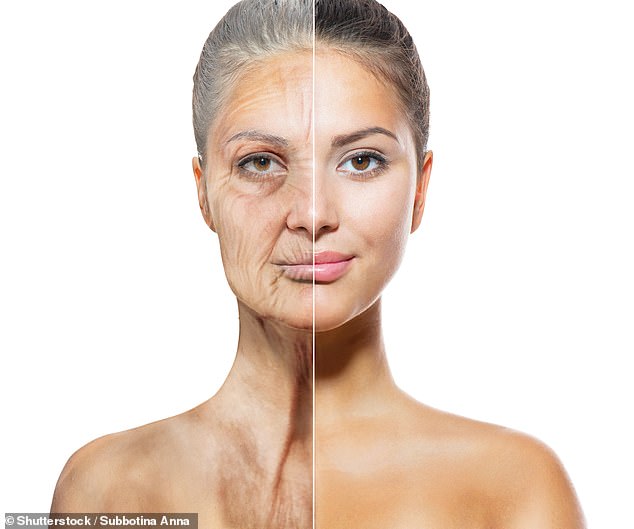Scientists discover possible secret to reversing aging
Ancient viruses, whose DNA has been hitchhiking in the human genome for thousands of years, may be the cause of many age-related diseases.
Scientists have proven for the first time that they can use this viral DNA – also called ‘retroelements’ – to predict the age of human cells with ‘high accuracy’.
In recent years, this seemingly inactive “junk” DNA from retroelements has been linked to everything from sleep patterns and memory formation to bipolar disorder.
Armed with their new ability to determine a person’s age via this ancient viral DNA, the scientists now plan to investigate whether new antiviral treatments can reverse the signs of aging by deactivating the worst of these viral “retroelement” genes.
Ancient viruses, whose DNA has been hitchhiking in the human genome for millennia, may be the cause of many age-related diseases that scientists now want to reverse
The new research uses previously unknown features of this ancient viral DNA to create a biological clock that can track a person’s age based on chemical changes in their DNA.
The researchers are now confident that new antiretroviral therapies, similar to those used to combat HIV and AIDS, could in the future reverse the signs of aging.
“Our findings indicate that retroelement clocks capture previously undiscovered facets of biological aging,” said study co-author Dr. Michael Corleyassociate professor of immunology at Weill Cornell Medicine in New York.
Dr. Corley stressed that the new study’s novel age-calculating technique, dubbed “Retro-Age” by his team, “could open the door to future treatments for this and other age-related conditions.”
At the heart of their new age-telling method is a process called methylation, which involves swapping parts of a DNA strand with a mixture of carbon and hydrogen atoms called a methyl group. This is a chemical tag that then activates that gene.
Changes in these ‘chemical tags’ on some ancient viral ‘retroelements’ appear to be linked to inflammation, instability within the genome, and some age-related diseases.
“Reactivation of specific retroelements increases with age, potentially leading to biological hallmarks of aging,” Dr. Corley said.
The Weill Cornell researcher, who specializes in such “epigenetic” markers, also noted that “cellular senescence,” or the phenomenon where aging cells stop multiplying through cell division, also appears to be linked to this activated old viral DNA.
Treatments that can stop the activity of this ancient viral DNA, the team has suggested, could turn back the clock on many physical symptoms of aging — from weathered skin to slowed muscle growth — but they wouldn’t cure the aging process itself.
The new research, published this month in the journal Aging cellused an AI machine learning model developed by Kentucky-based medical device company TruDiagnostic to track DNA methylation.
The company’s model was trained on the DNA data of approximately 12,670 people between the ages of 12 and 100.
Previous research has shown that as much as 8 percent of the human genome is made up of viruses, such as the ancient viral retroelements at the center of the new study.
Dr. Corley and his colleagues’ “Retro-Age” technique showed promise in two areas.
First, it helped them more accurately identify and document when a person’s so-called biological and chronological ages diverged.
Chronological age is simply measured by the number of years a person has lived.
While biological age indicates how old cells look based on their health and performance.
In addition, their work appeared to reveal an anti-aging effect associated with anti-virus antiretroviral drugs, which are also used to treat people with HIV/AIDS.

Their work appeared to reveal an anti-aging effect linked to antiretroviral drugs, such as those used to treat people with HIV/AIDS. “Whether antiretroviral therapy can be used as a therapeutic tool to improve health and extend lifespan,” they said, “requires further investigation.”
The team now hopes to conduct new studies to determine whether these treatments could have a similar anti-aging effect in people who are not yet battling HIV or another immunosuppressive virus.
“Whether antiretroviral therapy can be used as a therapeutic tool to improve health and extend lifespan,” they wrote in the new study, “requires further investigation.”
The next step, the researchers said, was to conduct a long-term study of people who received such therapies to protect themselves against HIV in advance, before possible future exposure, through treatments known as pre-exposure prophylaxis (PrEP).
PrEP uses antiretroviral drugs, sometimes in the form of pills such as tenofovir disoproxil fumarate, as a preventive measure to reduce the risk of HIV infection before it occurs.
“Analysis of the effects of pre-exposure prophylaxis (PrEP) (…) on retroelement-based epigenetic age,” the Weill Cornell team wrote, “may reveal potential effects of antiretroviral drugs on aging in HIV-negative people.”
Co-author of the study Dr. Lishomwa Ndhlovualso working at Weill Cornell, told reporters that the team also plans to investigate new treatments for age-related diseases by testing the epigenetic states of suspected retroelements in the human genome.
